Tracking Lake Anna’s History County by County

Montpelier, located in Orange County, is the family home of James and Dolley Madison. Madison was the fourth president of the United States and the third to hail from Virginia. The home is open for tours on Saturdays and Sundays with more information available on their website at www.Montpelier.org/visit (photo provided by the Virginia Department of Historic Resources).
By Irene Luck
Lake Anna is not only a beautiful place to live or visit any time of the year, but it is also rich in history dating back to before the formation of our country. Bordering counties Louisa, Orange, and Spotsylvania were each formed in the early to mid-1700s from other jurisdictions to the east as the population of the newly-founded colonies expanded. Each boasts its own rich history dating back even earlier, and they played important roles in the forming of America.
When European colonists first settled in the area, the inhabitants were a Siouan-speaking tribe called the Manahoac. Each county played pivotal roles in the build-up to the Revolutionary War and the battles that served to create the United States.
Louisa County
Louisa County was formed in 1742 when Hanover County was divided. The jurisdiction was named for Princess Louisa, daughter of King George II.
One of the hidden secrets of Louisa County is Jack Jouett’s ride, which never gained the notoriety of that of Paul Revere. Near the end of the Revolutionary War, Jouett was working in his father’s establishment, Cuckoo Tavern, near modern-day Mineral. When General Banastre Tarleton and his troops stopped there to rest, Jouett overheard them talking about orders to capture the Virginia Legislature. They also had their sights set on capturing outgoing governor Thomas Jefferson, who had fled to Charlottesville.
While Tarleton and his men were eating and drinking, Jouett rode 40 miles under cover of darkness to warn Jefferson and other government leaders of Tarleton’s plan. The leaders managed to escape further west, and the British plan was foiled.
Louisa County’s role in the new government continued after the war with tales of leaders and events occurring within the county’s borders. One of the most notable events involved the first president. According to Louisa County Historical Society documents, President George Washington was an overnight guest at Jerdone Castle in Bumpass on June 9, 1791.
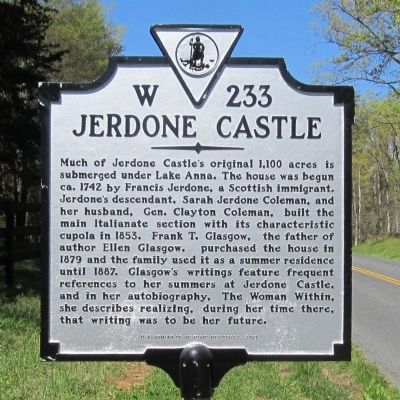
This marker designating the Jerdone Castle sits along the perimeter of the property on Moody Town Road (photos provided by the Virginia Department of Historic Resources).
Washington’s wife, Martha, was thought to be a close friend of Francis Jerdone’s wife, Sarah, who owned the property. The 1,100-acre plantation is believed to have been established around 1742 by Francis Jerdone, a man who came to Virginia from Scotland in 1740. In addition to expanding his original landholdings and building a residence, Jerdone operated stores, mills, and a forge.
Today the property is recognized for its historic significance as a Virginia Historic Landmark with two roadside markings. It is also registered on the U.S. National Register of Historical Places, but only 175 acres remain, with much of the original parcel now under Lake Anna.
The Jerdone family had quite an impact on the region, with Francis and Sarah’s sons owning property in Orange and Spotsylvania counties. Also, their grandson founded the town of Tolersville, later known as Mineral.
Another interesting visitor to Jerdone Castle was author Ellen Glasgow, whose father Frank T. Glasgow of Richmond purchased the estate in 1879. Ellen Glasgow spent her childhood summers at Jerdone Castle, which she later said greatly influenced her writing.
Today Jerdone Castle is owned by the Beardworth family.
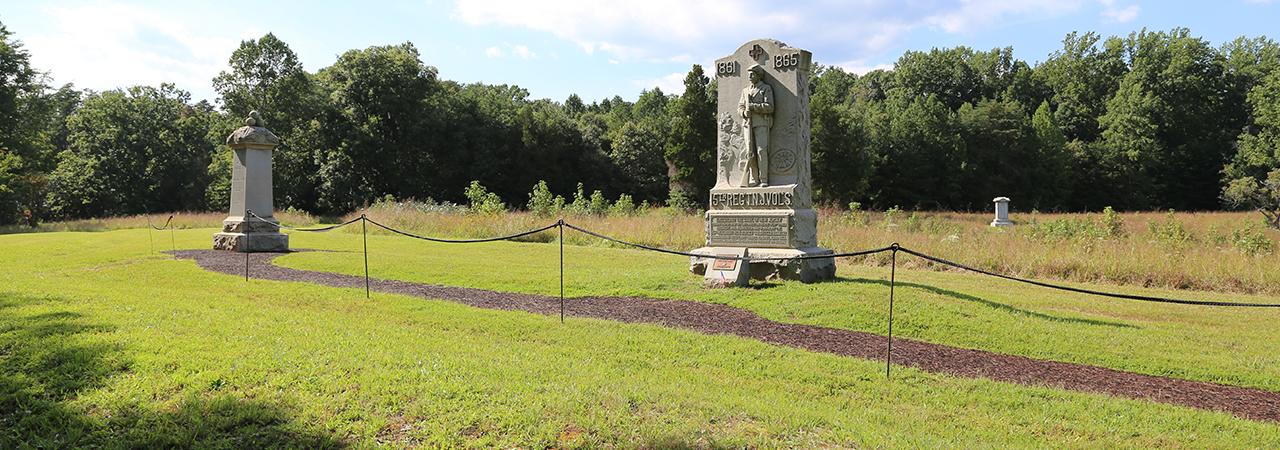
Pictured above is a portion of the battlefield grounds near the Spotsylvania County Courthouse. Numerous battlefield sites are open to the public during daylight hours and feature markers, statues, and memorials.
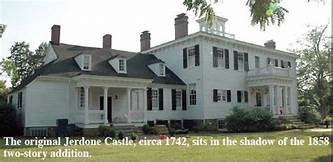
Jerdone Castle is located along the shores of Lake Anna in Bumpass and is privately owned. The property, much of which is now underwater from the formation of the lake, boasts the distinction of hosting President George Washington as a guest.
When it comes to Civil War history, Trevilians in Louisa County is the site of the largest all-Calvary battle of this great conflict. The Battle of Trevilian Station (also called Trevilians) was fought on June 11–12, 1864. Union cavalry under Maj. Gen. Philip Sheridan fought against Confederate cavalry under Maj. Gens. Wade Hampton and Fitzhugh Lee in the bloodiest and largest all-cavalry battle of the war.
After two days of bloody assaults, Sheridan withdrew his men to rejoin forces serving under Commanding General Ulysses S. Grant. The battle was a tactical victory for the Confederates, and Sheridan failed to achieve his goal of permanently destroying the Virginia Central Railroad or of linking up with General David Hunter. This distraction, however, may have contributed to Grant’s successful crossing of the James River.
For those interested in diving further into this interesting history, there is a driving tour of the area available as well as historic sites that are open periodically to visitors. The Louisa County Historical Society has a museum located in the town of Louisa featuring a wealth of information on the county’s rich history. More information is available at www.LouisaHistory.org.
Spotsylvania County
Spotsylvania County was carved from portions of Essex, King and Queen, and King William counties in 1721 and was named in Latin for the Lieutenant Governor of Virginia, Alexander Spotswood. Much of its historic significance relates to the Civil War. However, it is documented that Captain John Smith explored Spotsylvania County in the early 1600s when European colonists first landed.
This county was also the site of the first commercial ironworks in North America and had an early active gold mine that is now part of Lake Anna State Park. Fredericksburg, now an independent city, was once a town in Spotsylvania County.

The Spotsylvania County Courthouse sits on the site of the Battle of Spotsylvania, one of many Civil War encounters that took place within the county (photo provided by the Virginia Department of Historic Resources).
Spotsylvania County is known as “The Crossroads of the Civil War,” and the Spotsylvania Courthouse was the scene of one of the bloodiest engagements of that conflict. Because of its strategic importance, the intersection of Routes 613 and 208 controlled the shortest route to Richmond. Lee used the Spotswood Inn as an observation point, and Berea Christian Church was used as a hospital during the fighting.
Many of Spotsylvania’s battlefields have been preserved and are open to the public during daylight hours. There are also several museums in the area that highlight specific aspects of the county’s history. More information is available at www.Spotsylvania.va.us.
Orange County was created in 1734 from the western portion of Spotsylvania County and is thought to have once been the largest county in Virginia.
Orange County
Orange County was created in 1734 from the western portion of Spotsylvania County and is thought to have once been the largest county in Virginia. It stretched over the Blue Ridge Mountains to near what is today Waynesboro, although that honor was short lived when the western tract was split off into Augusta County.
Unlike other counties whose boundaries had ended at the Blue Ridge Mountains, Orange was bounded on the west “by the utmost limits of Virginia” which, at that time, stretched to the Mississippi River and the Great Lakes.
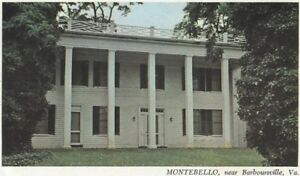
Montebello, located just outside of Gordonsville in Orange County, was home to our twelfth president, Zachary Taylor. A historic marker designates the property which sits just off Spotswood Trail (Rt. 33) near Old Montebello Drive. However, the home is not open to the public (photo provided by the Virginia Department of Historic Resources).
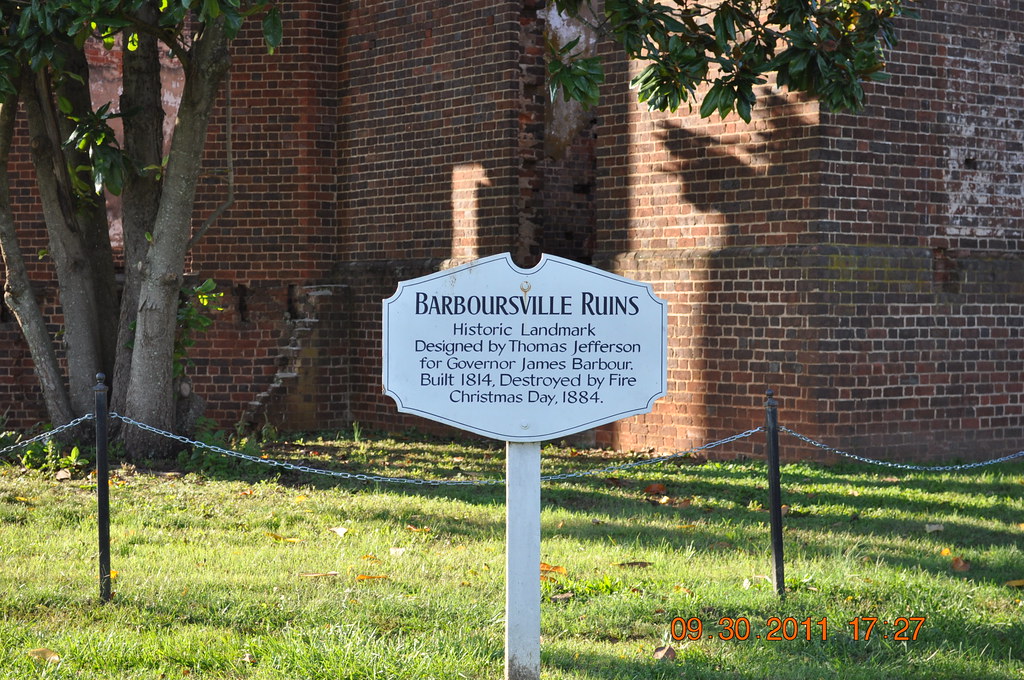
Barboursville_Ruins: Ruins are all that remain of the only building in Orange County known to have been designed by Thomas Jefferson. The home, which was destroyed by a fire on Christmas Day in 1884, was constructed between 1814 and 1822 for Virginia Governor James Barbour. The property is now part of Barboursville Vineyard and Winery and is open to the public. For more information visit www. BBVWine.com/heritage (photo provided by the Virginia Department of Historic Resources).
The first European settlement in what was to become Orange County was Germanna, formed when Governor Alexander Spotswood settled 12 immigrant families from Germany there in 1714. It began with a total of 42 people.
Orange County was spared much of the action of the Revolutionary War. Nonetheless, many of its residents fought in the battles.
During the Civil War, however, Orange County was instrumental in the action, as a major railroad ran through its borders from Richmond to Charlottesville and farther west. Several key battles were also held within its jurisdiction. Perhaps the county’s most noted claim to fame is as home to two early U.S. presidents, James Madison and Zachary Taylor. Madison, our fourth president, resided at Montpelier. Taylor, our twelfth president, dwelled at Montebello near Barboursville.
Both the towns of Orange and Gordonsville are recognized by the National Register of Historical Places, and the Exchange Hotel in Gordonsville was used as a hospital during the Civil War.
More information on Orange County’s history is available at www.OrangeCounty.va.gov.
Each of these areas share much more than merely bordering Lake Anna. For those looking for something to do on rainy or cool days, check out each of the county’s websites for more information. Or, simply get in your car for a road trip along the back roads, stopping to read the numerous historic markers found in the region. Even the small country stores have a story to tell, and the historic church cemeteries offer a more personal view of Lake Anna’s history.
Articles

RuraLove Ministries
This truck is filled with donations, some that have been picked and some to be delivered (submitted photo).by Kate Seltzer Four years before she could retire, Coral Losinski knew that she wanted to spend her retirement working at RuraLove’s thrift store. She...
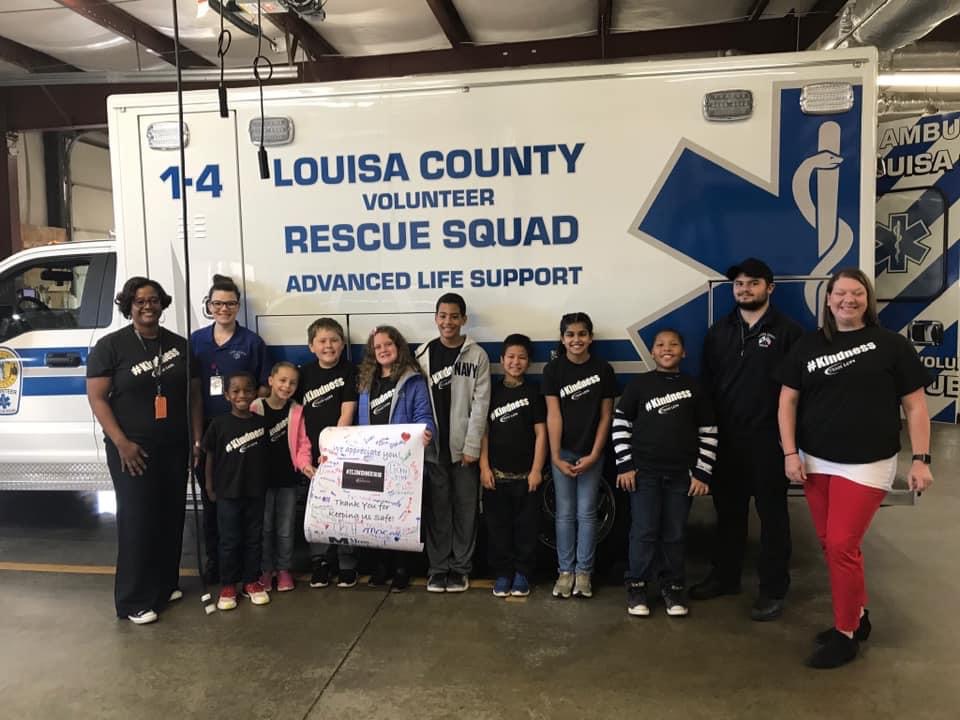
Louisa County Volunteer Rescue Squad
Louisa County Volunteer Rescue Squad members epitomize the definition of volunteerism, as the organization is still going strong 64 years after its formation. But, don’t let the name fool you – it’s not the only volunteer rescue squad in Louisa County.

